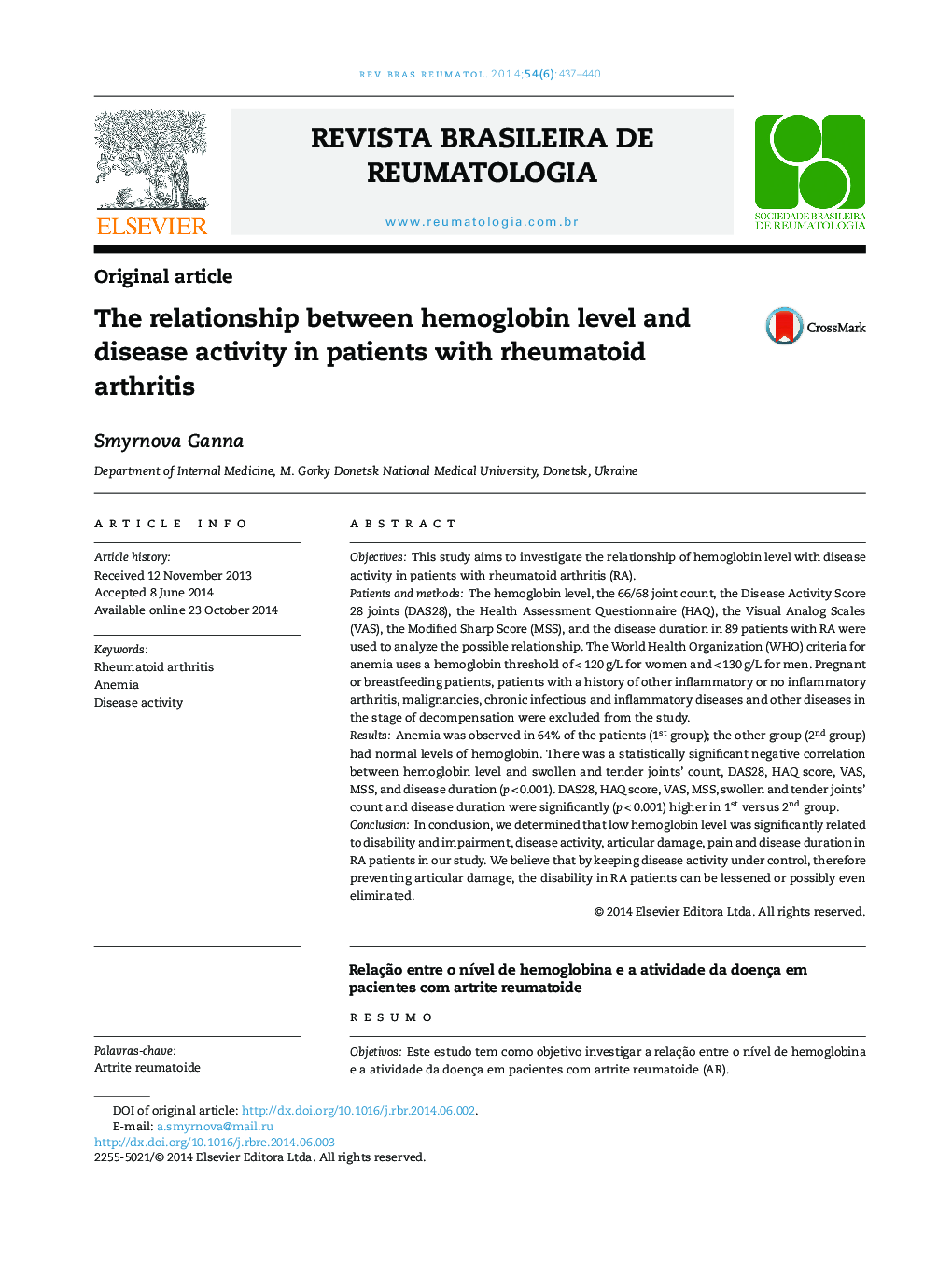| Article ID | Journal | Published Year | Pages | File Type |
|---|---|---|---|---|
| 3385113 | Revista Brasileira de Reumatologia (English Edition) | 2014 | 4 Pages |
ObjectivesThis study aims to investigate the relationship of hemoglobin level with disease activity in patients with rheumatoid arthritis (RA).Patients and methodsThe hemoglobin level, the 66/68 joint count, the Disease Activity Score 28 joints (DAS28), the Health Assessment Questionnaire (HAQ), the Visual Analog Scales (VAS), the Modified Sharp Score (MSS), and the disease duration in 89 patients with RA were used to analyze the possible relationship. The World Health Organization (WHO) criteria for anemia uses a hemoglobin threshold of < 120 g/L for women and < 130 g/L for men. Pregnant or breastfeeding patients, patients with a history of other inflammatory or no inflammatory arthritis, malignancies, chronic infectious and inflammatory diseases and other diseases in the stage of decompensation were excluded from the study.ResultsAnemia was observed in 64% of the patients (1st group); the other group (2nd group) had normal levels of hemoglobin. There was a statistically significant negative correlation between hemoglobin level and swollen and tender joints’ count, DAS28, HAQ score, VAS, MSS, and disease duration (p < 0.001). DAS28, HAQ score, VAS, MSS, swollen and tender joints’ count and disease duration were significantly (p < 0.001) higher in 1st versus 2nd group.ConclusionIn conclusion, we determined that low hemoglobin level was significantly related to disability and impairment, disease activity, articular damage, pain and disease duration in RA patients in our study. We believe that by keeping disease activity under control, therefore preventing articular damage, the disability in RA patients can be lessened or possibly even eliminated.
ResumoObjetivosEste estudo tem como objetivo investigar a relação entre o nível de hemoglobina e a atividade da doença em pacientes com artrite reumatoide (AR).Pacientes e métodosAvaliou-se a possível relação existente entre o nível de hemoglobina, a contagem de 66/68 articulações, o Escore de Atividade da Doença – 28 articulações (DAS28), o Questionário de Avaliação de Saúde (HAQ), a escala visual analógica (EVA), o Escore de Sharp modificado (MSS) e a duração da doença de 89 pacientes com AR. Os critérios para anemia da Organização Mundial de Saúde (OMS) consideram um limite de hemoglobina < 120 g/L para as mulheres e < 130 g/L para os homens. Pacientes grávidas ou amamentando, pacientes com história de outra artrite inflamatória ou não inflamatória, neoplasias, doenças crônicas infecciosas e inflamatórias e outras doenças descompensadas foram excluídas do estudo.ResultadosA anemia foi observada em 64% dos pacientes (1° grupo); o outro grupo (2° grupo) apresentou níveis normais de hemoglobina. Houve uma correlação negativa estatisticamente significativa entre o nível de hemoglobina e a contagem de articulações inchadas e sensíveis, DAS28, HAQ, EVA, MSS e duração da doença (p < 0,001). O DAS28, escore HAQ, EVA, MSS, contagem de articulações inchadas e sensíveis e duração da doença foram significativamente maiores (p < 0,001) no primeiro grupo em comparação com o segundo.ConclusãoDeterminou-se que o baixo nível de hemoglobina está significativamente correlacionado com a deficiência e incapacidade, atividade da doença, lesão articular, dor e duração da doença em pacientes com AR. Acredita-se que, mantendo a atividade da doença sob controle, evitando danos articulares será possível diminuir ou, possivelmente, até mesmo eliminar a incapacidade em pacientes com AR.
